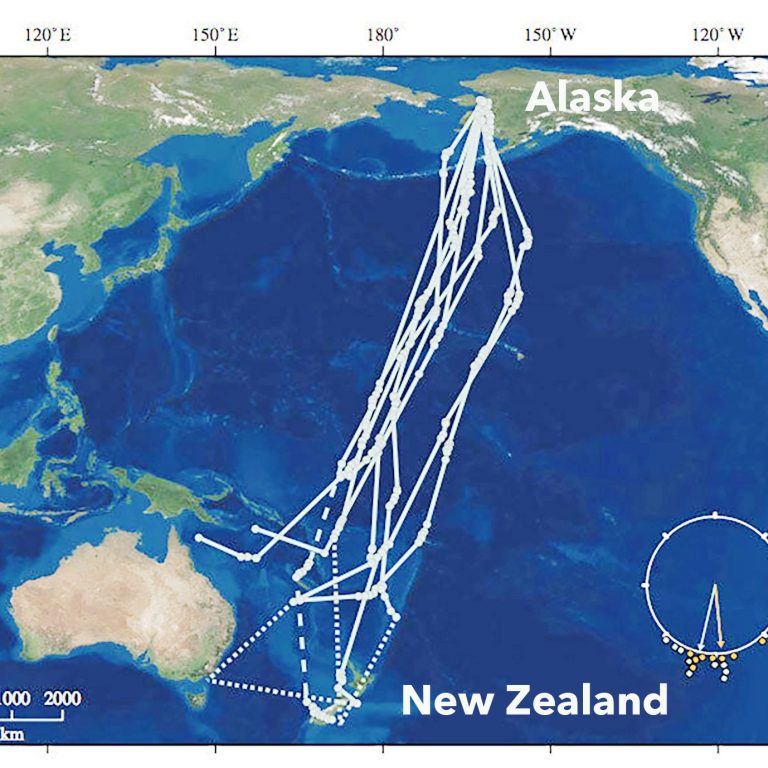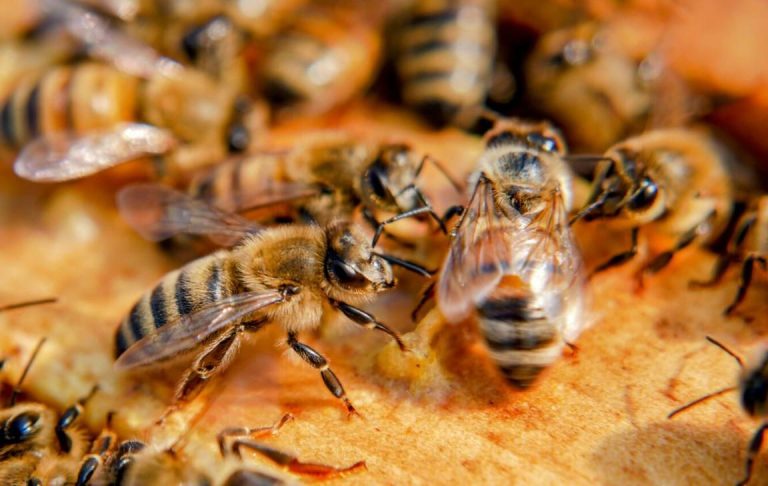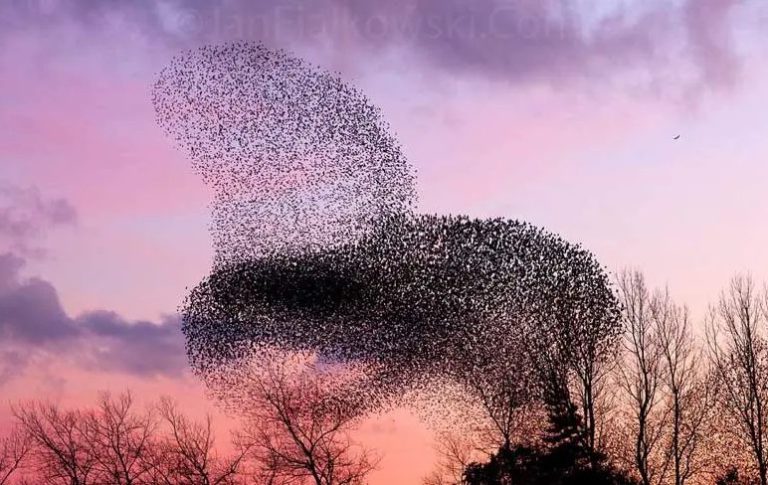18
The Navigators

Areodynamic perfection! The godwit in flight
7189 miles non-stop!
Can you believe it?
Surely it's impossible for anything to go that far without a break, let alone a small bird?
However unlikely it may seem, it is well documented that a bird called the bar-tailed godwit covered this distance on its migration from Alaska to New Zealand and back.

Robert E Gill,et al/USGS/The Royal Society
The bird, fitted with a satellite tracking device, was recorded flying non-stop for 6,350 miles from New Zealand to China. Then, after feeding for five well-deserved weeks, it flew another 4,013 miles to the Alaskan Peninsular. The same bird flew the return leg to New Zealand, covering 7,189 miles non-stop in 8 days. That is an average speed of about 35 m.p.h. for nearly 200 hours! For more about the godwit, see HERE.
The godwit may hold the record for non-stop flight, but it is not the only bird to cover such huge distances. The Arctic Tern completes the longest migration of any animal, from near the North Pole in the Arctic to spend the summer in the Antarctic – a round trip of 25–30,000 miles. The oldest known tern (42 years old) may have clocked up over one million miles in its lifetime.
But one of the most extraordinary migrations known to us is that of a much smaller animal, the monarch butterfly: amazing because it bridges several years and several successive generations. The route is the 2–3,000 miles between Canada and Mexico. The journey may take three or four generations, with the latest offspring sometimes returning to the very same tree occupied by their ancestors!

These astounding journeys pose an important question:
how do they know where they are going?
How do they set themselves a target destination, and how do they achieve it, sometimes with a quite remarkable degree of accuracy? And what applies to these great journeys also applies much further down the scale, to the ants and the bees and the dung beetles – how do they navigate through the daily routine of their more restricted lives?

Some of us may pride ourselves on our sense of direction, but in reality we have nothing that compares with these amazing navigational skills. Due to a lot of expensive hardware in the sky over our heads, a mobile phone can navigate to within a metre of any spot on earth – but without the latest GPS technology, we are helpless. For GPS see HERE
Eric Cassell (see Reference) identifies six different navigational strategies used by various animals. The most familiar to us is compass navigation.
This means essentially following a single cue which indicates geographic direction. In our case this means employing a compass which uses the earth's magnetic field to indicate north. Animals too use magnetism in this way, as well as other indicators like the sun, the stars and polarised light.

Magnetic compass
How does an animal sense the earth's magnetic field?
Research indicates that birds, for example, can have magnetic receptors in the retina, nose, beak and inner ear. The essential component of these receptors is magnetite, a highly magnetic iron oxide also known as 'lodestone'.
Amazingly, a wide variety of animals possess a biochemical process that can construct perfect crystals of biogenic magnetite (another of evolution's happy accidents!). This material is of course worthless unless its unique magnetic properties are completely integrated into the animal's nervous system and intelligence. The need for a Designer/Engineer is inescapable!
The sensor indicates the direction of north, and the animal then has to calculate the angle between north and its desired direction of travel. It also has to maintain that angle throughout its journey, however long that may be, and compensate for the effects of wind and weather. Some animals are also able to detect other aspects of the magnetic field, its intensity and its inclination angle, to establish their position.
Using the sun as a compass
I expect we have all done it at some time or another. If we can see the sun, then we can roughly guess the time of the day and the direction of north. But animals have developed this to a fine art. The sun moves continuously in an East-West arc through the day, and its position relative to north at any one time is not simple. It varies not just over the course of the day but with latitude and through the course of the year. The animal needs to have its own internal clock (known as a 'circadian clock') to allow it to compensate for these changes in the sun's position. So it's far from being straightforward, but many animals are able instinctively to carry out the calculations required.
They are also able to interpret sunlight in a way that we do not.
As light from the sun passes through our atmosphere, it becomes partially polarised; hence the effectiveness of polarising sunglasses in reducing its intensity. Many animals can detect this polarised light and from it deduce the position of the sun even on a heavily clouded day. Again they need to know how to compensate for the changes in polarisation through the day and through the seasons.
Navigation using the stars
The 'pole point' is the spot in the sky around which the sun moon and stars appear to rotate as the earth rotates, and it seems that birds can locate it and use it as a reference by watching the constellations rotate around it. In the Northern Hemisphere the Pole star is very close to this point, hence its name. The same thing happens in the Southern Hemisphere, with the Southern Cross constellation rotating about the pole point.

"As with other compasses, the origin of the use of pole points for animal navigation is a mystery. The behaviour is programmed and complex ...animal types ...do not learn it. They just know it. The ability is innate" – Eric Cassells (see Reference).
'Map Sense'
Some animals are able to construct a complete mental map rather than a direction or heading, and this is described as a 'map sense'. Like the homing pigeon, for example: the bird can find its way to a given location from any other location, a natural General Positioning System.
Animals may use more than one of these different systems, and use them to inform and cross-check each other.

A bit of history
Eratosthenese (276 – 196 BC) was the first to use imaginary lines of latitude and longitude to define locations on the earth. So it has taken the human race over two thousand years to come up with the GPS navigation system which is commonly used today. We know the story of how it was done, and the complex geometry and calculations still required.
It is surely inconceivable that these amazing abilities in the natural world were arrived at accidentally, by a Darwinian system of very small random changes, each selected only for their survival value.
'God of the Gaps'
Believers are sometimes accused of believing in a 'God of the Gaps', where God is used simply to cover up our current ignorance. Science, many believe, will eventually give us all the answers we need without any divine intervention required.
The reality is quite the reverse!
The 'gaps' are in the theory of evolution, holes which are routinely skated over and covered up by imaginative fairy tales which disguise the absence of real evidence. The more science advances and our knowledge increases, the more complex, finely balanced and engineered our wonderful natural world is seen to be:
earth.com

GomezDavid / istock
Jan Fialkovski
A single bee, returned from its foraging, has found and memorised the location of a rich source of nectar, and passes that information on to its fellows with an elaborate dance (the 'waggle dance' as it has become known);

Thousands of starlings flock together in a collective display of formation flying, a 'murmuration', where each bird has to keep its position relative to all the others, at high speed and unbelievable accuracy.
What vital purpose is served by this astonishing display that would cause evolution to select it?
Jurgen Freund NATURE PICTURE LIBRARY

These newly-hatched leatherback turtles skitter across the sand to the sea, their baby brains already programmed with the coordinates for their first great adventure.
As we too navigate our way through an often dangerous and hostile world, we join the generations of these amazing animals. Our Creator has given us all the tools we need for the job. He has a purpose with us – all we need is the intelligence and faith to recognise Him and follow wherever He leads us.
REFERENCE: 'Animal Algorithms – Evolution and the Mysterious Origin of Ingenious Instincts' Eric Cassell Discovery Institute Press 2021
Eric is experienced in systems engineering related to aircraft navigation and safety, and has acted as a consultant to NASA and the FA
Researchgate.net
We do not use cookies on this website. We do not collect any of your personal details, and our list of subscribers is not shared with any third party.
Intelligence and purpose in the natural world
We need your consent to load the translations
We use a third-party service to translate the website content that may collect data about your activity. Please review the details in the privacy policy and accept the service to view the translations.
